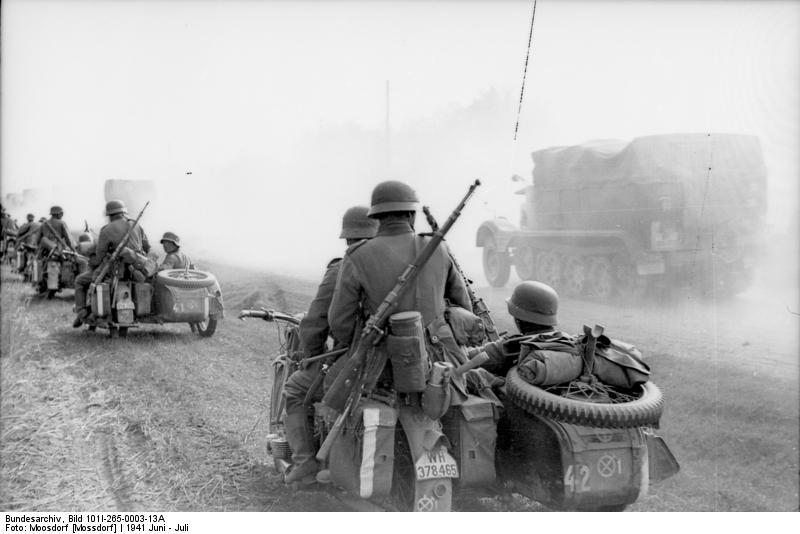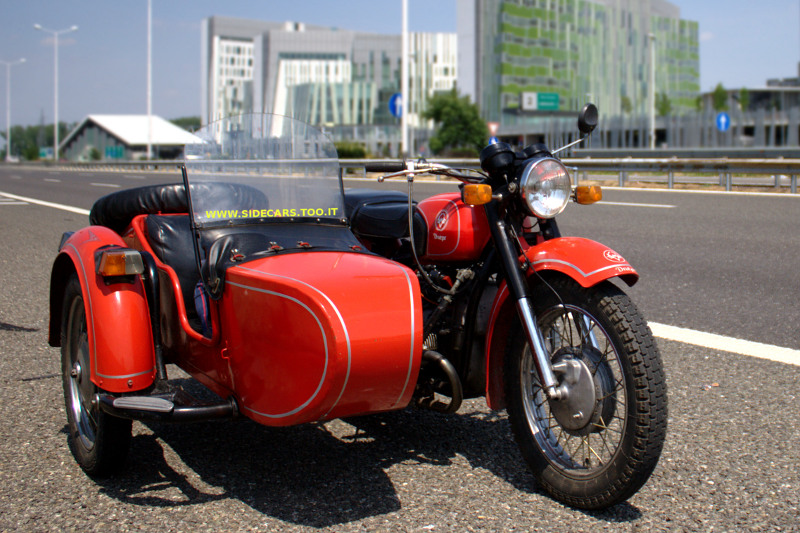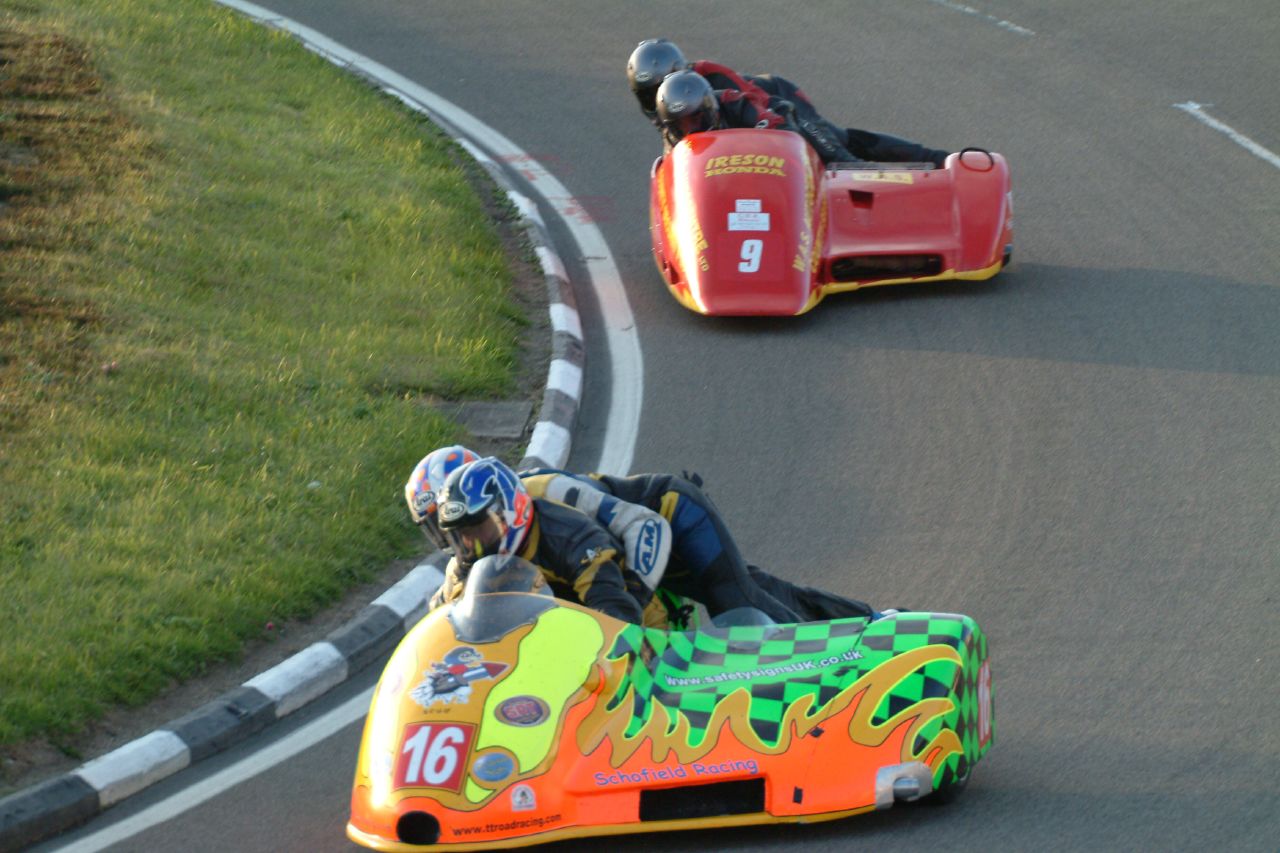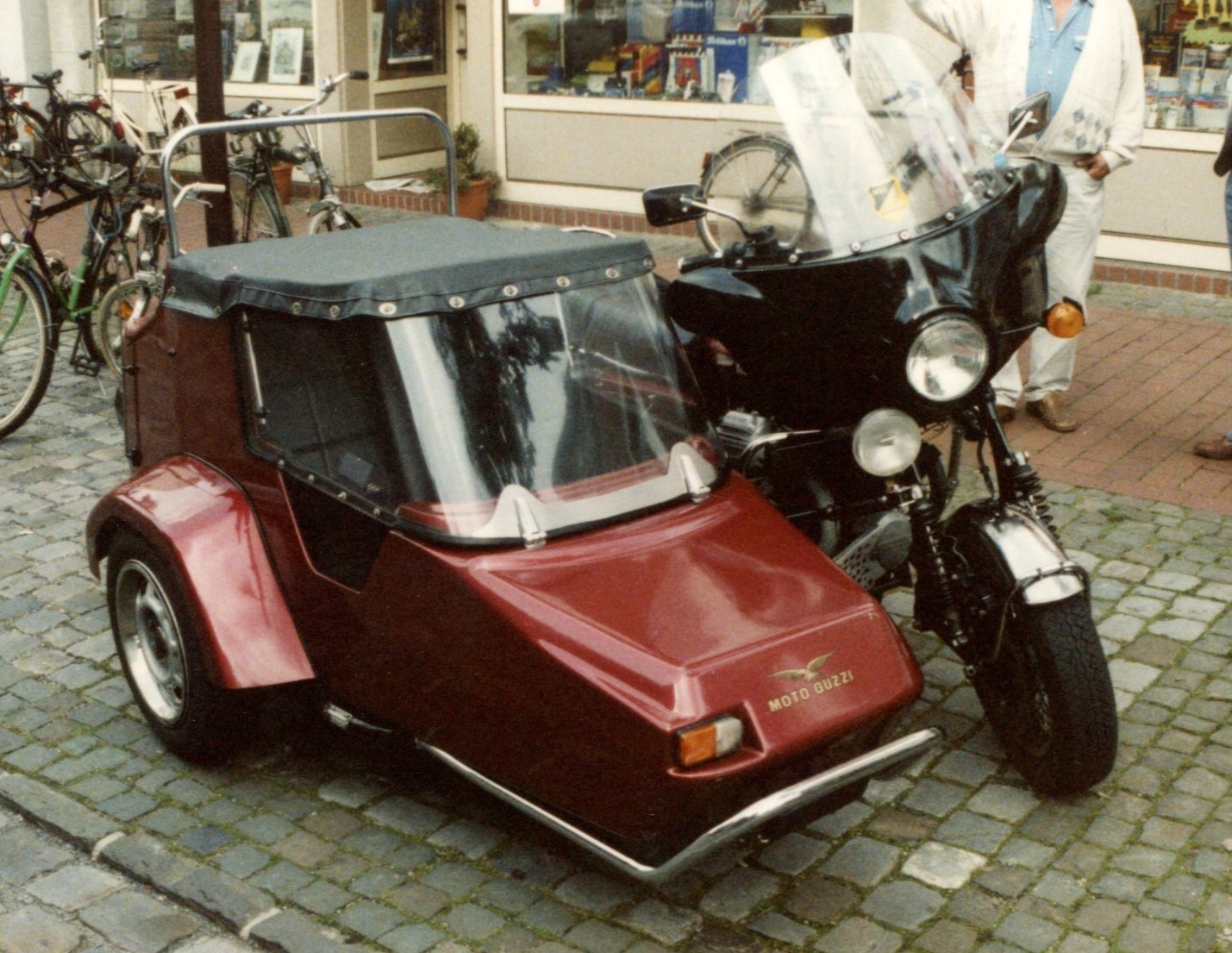Sidecar on:
[Wikipedia]
[Google]
[Amazon]
 A sidecar is a one-wheeled device attached to the side of a
A sidecar is a one-wheeled device attached to the side of a

 Jean Bertoux, a French army officer, secured a prize offered by a French newspaper in 1893 for the best method of carrying a passenger on a bicycle. The sidecar wheel was mounted on the same lateral plane as the bicycle's rear and was supported by a triangulation of tubes from the bicycle. A sprung seat with back rest was mounted above the cross-member and a footboard hung below.
A sidecar appeared in a cartoon by George Moore in the January 7, 1903, issue of the British newspaper ''
Jean Bertoux, a French army officer, secured a prize offered by a French newspaper in 1893 for the best method of carrying a passenger on a bicycle. The sidecar wheel was mounted on the same lateral plane as the bicycle's rear and was supported by a triangulation of tubes from the bicycle. A sprung seat with back rest was mounted above the cross-member and a footboard hung below.
A sidecar appeared in a cartoon by George Moore in the January 7, 1903, issue of the British newspaper ''
 A sidecar motorcycle is a three-wheeled vehicle with the side wheel not directly aligned with the rear motorcycle wheel, and is usually powered by the rear wheel only. This is different from a
A sidecar motorcycle is a three-wheeled vehicle with the side wheel not directly aligned with the rear motorcycle wheel, and is usually powered by the rear wheel only. This is different from a  The sidecar consists of a frame and of a body. The frame may either be fixed to the bike, or it may be attached in a way which makes the bike able to lean in the same manner as bikes without sidecars. Also, Ural had a reversible sidecar for the European market.
The body typically provides one passenger seat and a small trunk compartment behind. In some cases the sidecar has a removable soft top. In some modifications, the sidecar's body is used for carrying cargo or tools, like a truck's platform. The sidecar is typically mounted so that the motorcycle is closer to the centre of the road, i.e. with the sidecar on the right for right-hand traffic.
The sidecar consists of a frame and of a body. The frame may either be fixed to the bike, or it may be attached in a way which makes the bike able to lean in the same manner as bikes without sidecars. Also, Ural had a reversible sidecar for the European market.
The body typically provides one passenger seat and a small trunk compartment behind. In some cases the sidecar has a removable soft top. In some modifications, the sidecar's body is used for carrying cargo or tools, like a truck's platform. The sidecar is typically mounted so that the motorcycle is closer to the centre of the road, i.e. with the sidecar on the right for right-hand traffic.
 A sidecar makes the bike asymmetrical. A fixed mounted rig with right mounted sidecar can go faster in left turns than in right turns because the sidecar prevents it from tipping over. In right turns, they can tip over if curves are taken too fast. Some techniques can be used to take a right curve faster without tipping, like usage of the brake on the sidecar, if one is fitted.
While a sidecar pilot is described as driving rather than riding, with all but the heaviest rigs, the comparison to a car is weak. Driver and passenger body position affect higher speed handling, especially on dirt or other uneven surfaces. If the sidecar and bike geometry are not coordinated the combination will be unstable, especially at speed, with shimmy upon acceleration or deceleration.
In rigid mounted rigs, leaning the motorcycle by clamping it rigidly a few degrees away from the sidecar is used along with a few degrees of "toe-in" of the sidecar wheel toward the centerline of the vehicle to allow for road camber and provide a balance resulting in comfortable, straight line travel. Most sidecars are also fitted with steering damping devices of either friction or hydraulic type to lessen the effects of sudden inputs, as encountered on rough roads, upon the vehicle's handling.
A sidecar makes the bike asymmetrical. A fixed mounted rig with right mounted sidecar can go faster in left turns than in right turns because the sidecar prevents it from tipping over. In right turns, they can tip over if curves are taken too fast. Some techniques can be used to take a right curve faster without tipping, like usage of the brake on the sidecar, if one is fitted.
While a sidecar pilot is described as driving rather than riding, with all but the heaviest rigs, the comparison to a car is weak. Driver and passenger body position affect higher speed handling, especially on dirt or other uneven surfaces. If the sidecar and bike geometry are not coordinated the combination will be unstable, especially at speed, with shimmy upon acceleration or deceleration.
In rigid mounted rigs, leaning the motorcycle by clamping it rigidly a few degrees away from the sidecar is used along with a few degrees of "toe-in" of the sidecar wheel toward the centerline of the vehicle to allow for road camber and provide a balance resulting in comfortable, straight line travel. Most sidecars are also fitted with steering damping devices of either friction or hydraulic type to lessen the effects of sudden inputs, as encountered on rough roads, upon the vehicle's handling.
 Sidecar racing events exist in
Sidecar racing events exist in
 During
During

 Although sidecars have become much less common since the mid-1950s, a number of manufacturers worldwide have continued to produce sidecars for many popular motorcycles and scooters.
Although sidecars have become much less common since the mid-1950s, a number of manufacturers worldwide have continued to produce sidecars for many popular motorcycles and scooters.
 A sidecar is a one-wheeled device attached to the side of a
A sidecar is a one-wheeled device attached to the side of a motorcycle
A motorcycle (motorbike, bike, or trike (if three-wheeled)) is a two or three-wheeled motor vehicle Steering, steered by a Motorcycle handlebar, handlebar. Motorcycle design varies greatly to suit a range of different purposes: Long-distance ...
, scooter, or bicycle
A bicycle, also called a pedal cycle, bike or cycle, is a human-powered or motor-powered assisted, pedal-driven, single-track vehicle, having two wheels attached to a frame, one behind the other. A is called a cyclist, or bicyclist.
B ...
, making the whole a three-wheeled vehicle. A motorcycle with a sidecar is sometimes called a ''combination'', an ''outfit'', a ''rig'' or a ''hack''.
History

 Jean Bertoux, a French army officer, secured a prize offered by a French newspaper in 1893 for the best method of carrying a passenger on a bicycle. The sidecar wheel was mounted on the same lateral plane as the bicycle's rear and was supported by a triangulation of tubes from the bicycle. A sprung seat with back rest was mounted above the cross-member and a footboard hung below.
A sidecar appeared in a cartoon by George Moore in the January 7, 1903, issue of the British newspaper ''
Jean Bertoux, a French army officer, secured a prize offered by a French newspaper in 1893 for the best method of carrying a passenger on a bicycle. The sidecar wheel was mounted on the same lateral plane as the bicycle's rear and was supported by a triangulation of tubes from the bicycle. A sprung seat with back rest was mounted above the cross-member and a footboard hung below.
A sidecar appeared in a cartoon by George Moore in the January 7, 1903, issue of the British newspaper ''Motor Cycling
Motorcycling is the act of riding a motorcycle. For some people, motorcycling may be the only affordable form of individual motorized transportation, and small-displacement motorcycles are the most common motor vehicle in the most populous co ...
''. Three weeks later, a provisional patent was granted to Mr. W. J. Graham of Graham Brothers, Enfield, Middlesex. He partnered with Jonathan A. Kahn to begin production.
One of Britain's oldest sidecar manufacturers, Watsonian, was founded in 1912. It is still trading as Watsonian Squire. Automobile producer Jaguar Cars
Jaguar (, ) is the luxury vehicle brand of Jaguar Land Rover, a British multinational car manufacturer with its headquarters in Whitley, Coventry, England. Jaguar Cars was the company that was responsible for the production of Jaguar car ...
was founded in 1922 as a sidecar manufacturer, the Swallow Sidecar Company.
In 1913, American inventor Hugo Young, of Loudonville, Ohio, designed a new sidecar which was not rigidly fixed to the motorcycle. Instead, his invention employed a flexible connection, which allowed the sidecar to turn, raise, and lower without affecting the balance of the motorcycle. This was a great improvement over the original design, allowing for much safer and more comfortable experiences for both the passenger and driver. Young opened up the Flxible Sidecar Company (the first "e" was dropped to allow for trademarking the name) in Loudonville, Ohio and soon became the largest sidecar manufacturer in the world (the company closed in 1996). When the motorcycle craze began to fade in the 1920s due to more affordable cars being marketed, as well as the banishment of sidecar racing in the United States, the Flxible Sidecar Company began producing transit buses, ambulances, and hearses.
Until the 1950s sidecars were quite popular, providing a cheap alternative to passenger cars; they have also been used by armed forces
A military, also known collectively as armed forces, is a heavily armed, highly organized force primarily intended for warfare. It is typically authorized and maintained by a sovereign state, with its members identifiable by their distinct ...
, police
The police are a Law enforcement organization, constituted body of Law enforcement officer, persons empowered by a State (polity), state, with the aim to law enforcement, enforce the law, to ensure the safety, health and possessions of citize ...
and the UK's AA and RAC motoring organisations.
Design
 A sidecar motorcycle is a three-wheeled vehicle with the side wheel not directly aligned with the rear motorcycle wheel, and is usually powered by the rear wheel only. This is different from a
A sidecar motorcycle is a three-wheeled vehicle with the side wheel not directly aligned with the rear motorcycle wheel, and is usually powered by the rear wheel only. This is different from a motor tricycle
A motorized tricycle, motor trike, or motortrycle is a three-wheeled vehicle based on the same technology as a bicycle or motorcycle, and powered by an electric motor, motorcycle, scooter or car engine.
Classification
Depending on the design ...
(trike), where both rear wheels are powered and share a common axle. However, either P.V. Mokharov of the Soviet Union or H.P. Baughn of Great Britain seem to have been the first to employ a driven sidecar wheel in 1929. Baughn two-wheel-drive outfits were so successful in trials events in the early 1930s that there were attempts to have the ACU ban them from competition. A great many companies experimented with two-wheel drive in sporting events and indeed many companies employed them in military vehicles prior to the commencement of World War II. Currently, the Russian manufacturer Ural produces several models with two-wheel drive that can be engaged as desired.
 The sidecar consists of a frame and of a body. The frame may either be fixed to the bike, or it may be attached in a way which makes the bike able to lean in the same manner as bikes without sidecars. Also, Ural had a reversible sidecar for the European market.
The body typically provides one passenger seat and a small trunk compartment behind. In some cases the sidecar has a removable soft top. In some modifications, the sidecar's body is used for carrying cargo or tools, like a truck's platform. The sidecar is typically mounted so that the motorcycle is closer to the centre of the road, i.e. with the sidecar on the right for right-hand traffic.
The sidecar consists of a frame and of a body. The frame may either be fixed to the bike, or it may be attached in a way which makes the bike able to lean in the same manner as bikes without sidecars. Also, Ural had a reversible sidecar for the European market.
The body typically provides one passenger seat and a small trunk compartment behind. In some cases the sidecar has a removable soft top. In some modifications, the sidecar's body is used for carrying cargo or tools, like a truck's platform. The sidecar is typically mounted so that the motorcycle is closer to the centre of the road, i.e. with the sidecar on the right for right-hand traffic.
Handling
Sport
 Sidecar racing events exist in
Sidecar racing events exist in motocross
Motocross is a form of off-road motorcycle racing held on enclosed off-road circuits. The sport evolved from motorcycle trials competitions held in the United Kingdom.
History
Motocross first evolved in Britain from motorcycle trials competiti ...
(see sidecarcross), enduro, grasstrack, trial
In law, a trial is a coming together of parties to a dispute, to present information (in the form of evidence) in a tribunal, a formal setting with the authority to adjudicate claims or disputes. One form of tribunal is a court. The tribun ...
, road racing
Road racing is a form of motorsport racing held on a paved road surface. The races can be held either on a closed circuit or on a street circuit utilizing temporarily closed public roads. Originally, road races were held almost entirely on publ ...
and speedway with sidecar classes. The sport has followers in Europe, the United States, Japan, Australia and New Zealand. The sidecars are often classed by age or engine size, with historic sidecar racing often being more popular than its modern counterpart. Older classes in road racing generally resemble solo motorcycles with a platform attached, where modern racing sidecars are low and long and borrow much technology from open wheel race cars. In all types of sidecar racing there is a rider and a passenger who work in unison to make the machine perform, as they would be almost unrideable without the passenger in the correct position.
Road racing sidecars began to change away from normal motorcycle development in the 1950s with them becoming lower and using smaller diameter wheels and they kept the enclosed "dustbin fairing" banned in solo competition in 1957. By the 1970s, they were using wide slick tyres with a square car-like profile, the rider kneeled behind the engine instead of sitting on a seat and the motor of choice was generally a 500 cc two stroke. In the late 1970s sidecars began to appear with hub centre steering and later the engines moved to the rear of the rider, to lower the centre of gravity further still, making the sidecar very long. Sidecars raced in the Sidecar World Championship are all hub centre long monocoque
Monocoque ( ), also called structural skin, is a structural system in which loads are supported by an object's external skin, in a manner similar to an egg shell. The word ''monocoque'' is a French term for "single shell".
First used for boats, ...
framed machines, the most common being LCR, ART or Windle, with 1,000 cc four-cylinder four-stroke engines, the most popular being the Suzuki GSX-R1000.
These at club and national level are known as Formula One sidecars, as opposed to Formula Two. Formula Two sidecars are short front engined bikes, which must have a frame made of steel tube and have leading link forks as monocoques and hub centre steering is banned. Engines are 350 cc two strokes or 600 cc four strokes. F2 sidecars are raced in their own championship but are often on track at the same time as the F1s, but competing for their own points. Since 1990 at the Isle of Man TT
The Isle of Man TT or Tourist Trophy races are an annual motorcycle racing event run on the Isle of Man in May/June of most years since its inaugural race in 1907. The event is often called one of the most dangerous racing events in the world ...
, the Sidecar TT
The Sidecar TT is a motorcycle-with-sidecar road race competition held over two legs which takes place during the Isle of Man TT festival, an annual event at the end of May and beginning of June. Between 1954 and 1976 this race was part of the Gr ...
has been solely contested by Formula Two sidecars as Formula Ones were deemed too fast, then lapping at average. By 2006 however, F2s were faster than this lapping at .
Military use
 During
During World War I
World War I (28 July 1914 11 November 1918), often abbreviated as WWI, was List of wars and anthropogenic disasters by death toll, one of the deadliest global conflicts in history. Belligerents included much of Europe, the Russian Empire, ...
, the British Army
The British Army is the principal land warfare force of the United Kingdom, a part of the British Armed Forces along with the Royal Navy and the Royal Air Force. , the British Army comprises 79,380 regular full-time personnel, 4,090 Gurkha ...
sought to increase the mobility of its Vickers machine gun
The Vickers machine gun or Vickers gun is a water-cooled .303 British (7.7 mm) machine gun produced by Vickers Limited, originally for the British Army. The gun was operated by a three-man crew but typically required more men to move and o ...
s. A gun and its tripod weighed between ; cooling water was also required and ammunition boxes weighted a further each; each gun required a six to eight man team to carry it.
A solution to this problem was to fit the guns to sidecar motorcycles. This would allow the guns to be moved rapidly between different sectors, and allow them to quickly pursue retreating enemy troops. Clyno motorcycles were initially adopted; these could carry the gun, tripod, water and spare parts, as well as seven ammunition boxes; they were supported by unarmed sidecar motorcycles that carried only ammunition. A number of different motorcycles were eventually used. A special unit, the Motor Machine Gun Service, was formed to operate them, but the static nature of trench warfare meant the unit was infrequently used.
During World War II
World War II or the Second World War, often abbreviated as WWII or WW2, was a world war that lasted from 1939 to 1945. It involved the World War II by country, vast majority of the world's countries—including all of the great power ...
, German troops used many BMW and Zündapp sidecar motorcycles. On German, Italian, French, Belgian, British and Soviet military sidecars, the side wheel was sometimes also driven, sometimes using a differential gear
A differential is a gear train with three drive shafts that has the property that the rotational speed of one shaft is the average of the speeds of the others, or a fixed multiple of that average.
Functional description
The following descri ...
, to improve the vehicle's all-terrain ability.
Regulation
The sidecar is normally fitted to the right of the motorcycle in jurisdictions where traffic keeps to the right side of the road; the sidecar's position is reversed in left-side jurisdictions. This matches the usual configuration of driver and front-seat passenger in cars. In the UK, sidecars fitted to the right side are prohibited on motorcycles registered after August 1981. In Italy, left-mounted sidecars were prohibited in 1924, though the ban was not enforced until 1959. In the Republic of China (Taiwan), Article 39-2 of the Road Traffic Security Rules ( zh:道路交通安全規則) prohibits the registration of new motorcycles with sidecars but does not specifically restrict fitting them later.Flexible sidecars
Several flexible sidecars, not rigidly attached to the motorcycle, have been developed. This can help deal with issues of uneven pavement and allow leaning the bike into turns.Bicycle sidecars
Sidecars have sometimes been fitted on bicycles. The "Watsonian" brand was popular from the 1930s to the 1950s in the UK. The Philippinetrisikad
The cycle rickshaw is a small-scale local means of transport. It is a type of hatchback tricycle designed to carry passengers on a for-hire basis. It is also known by a variety of other names such as bike taxi, velotaxi, pedicab, bikecab, ...
is a type in current use.
Manufacturers

 Although sidecars have become much less common since the mid-1950s, a number of manufacturers worldwide have continued to produce sidecars for many popular motorcycles and scooters.
Although sidecars have become much less common since the mid-1950s, a number of manufacturers worldwide have continued to produce sidecars for many popular motorcycles and scooters.
See also
*Cossack motorcycle
Satra Corporation was a US trading and metal processing company. It is primarily known in the United Kingdom for its Satra Motors Limited subsidiary, which was the official importer and distributor of Soviet Union cars and motorcycles in that co ...
* Outline of cycling
:''This article is an outline about the activity of cycling. For an outline about bicycles themselves, see outline of bicycles.''
:The following ''outline'' is provided as an overview of, as well as a topical guide to cycling:
Cycling, a ...
* Motorcycle ambulance
Motorcycle ambulances are a type of emergency vehicle which either carries a solo paramedic or first responder to a patient; or is used with a trailer or sidecar for transporting patients. Because of its size and performance, a motorcycle amb ...
* Riders for Health
Riders for Health is a non-governmental organization (NGO) that specialises in supplying, managing and maintaining vehicles for health-focused organisations in African countries. Motorcycles are well-suited for delivering health care in Africa, ...
a charity which provides the "Uhuru", a sidecar ambulance, to communities in Africa
* Outline of motorcycles and motorcycling
* Tilting three-wheeler
* Motorized tricycle (Philippines)
References
Notes
Sources
* * * * *External links
* {{Motorcycles Vehicles introduced in 1893